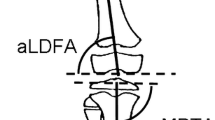Summary
A growth plate injury can lead to a total or partial epiphysiodesis. In the first case, a leg length discrepancy will occur, due to the growth arrest of the injured plate. The anticipation of the discrepancy at skeletal maturity is achieved with the Green and Anderson data, either with the arithmetic method, the growth remaining charts, or the Moseley straight line graph. In case of a partial excentric epiphysiodesis, the future growth will lead to a progressive angular deformity, and the prognosis can be approached with the Bowen graph. If the injury is located at the metaphyseal area, a temporary overgrowth can be observed, due to a delay in maturation of the ossification front. The growth velocity returns to a normal value usually after one or two years, but the final prognosis is difficult to establish. Finally, the growth plate acts as a remodelling factor for some metaphyseal and diaphyseal malunions. The potential of remodelling depends on the age of the child, the proximity of the malunion to the plate, and the plane of the deformity. A good knowledge of these rules can help to determine the tolerance levels of incomplete reductions of children's fractures.
Résumé
Le traumatisme d'un cartilage de croissance peut induire une épiphysiodèse totale ou partielle. Dans le premier cas, la conséquence sera une inégalité de longueur pure par perte de l'activité de croissance du cartilage lésé. L'anticipation de cette inégalité à maturité osseuse est facilement déterminée par les données de Green et Anderson, soit par la méthode arithmétique, soit par les courbes de croissance résiduelle, soit enfin par les méthodes graphiques de Moseley ou de Carlioz. Dans le cas d'une épiphysiodèse partielle excentrée, la croissance va occasionner une déviation angulaire évolutive, dont le pronostic final peut être approché par les courbes de Bowen. Si le traumatisme porte sur la région métaphysaire et respecte la plaque conjugale, on peut observer une hypercroissance transitoire par retard de maturation du front d'ossification. La vélocité de croissance se normalise le plus souvent après un an ou deux, mais le pronostic final est très difficile à établir. Enfin le cartilage de croissance intervient comme élément de remodelage de certains défauts de réduction diaphyso-métaphysaires. Les potentialités de ce remodelage dépendent de l'âge de l'enfant, de la proximité du cal vicieux par rapport au cartilage de croissance et du plan de la déformation. Une bonne connaissance de ces mécanismes permet de déterminer les seuils de tolérance des défauts de réduction des fractures récentes.
Similar content being viewed by others
Bibliographie
Anderson M, Green WT, Messner MB (1963) The Classic. Growth and predictions of growth in the lower extremities. J Bone Joint Surg [Am] 45-A: 1–21
Bowen JR, Leahey JL, Zhang Z, MacEwen GD (1985) Partial epiphysiodesis at the knee to correct angular deformity. Clin Orthop Rel Res 188: 184–190
Carlioz H, Filipe G (1987) Inégalités de longueur des membres inférieurs. Cahier d'Enseignement de la SOFCOT No 27. Expansion Scientifique Française
Coleman SS (1986) Lower limb discrepancy in pediatric orthopedics, 2nd edn. In: Lovell WW, Winter RB (eds) JB Lippincott, Philadelphia, pp 781–863
Hechard P, Carlioz H (1978) Méthode pratique de prévision des inégalités de longueur des membres inférieurs. Rev Chir Orthop 64: 81–87
Heripret C, Perves A, Taussig G (1972) Inégalités de longueur des membres inférieurs. Prévisions et indications générales pendant la croissance. Rev Chir Orthop 38: 733–739
Karger C, Dietz JM, Heckel T, De Thomasson E, Briot B (1986) Devenir des cals vicieux diaphysaires de l'avant-bras chez l'enfant. Rev Chir Orthop 72 [Suppl II]: 44–47
Menelaus MB (1966) Correction of leg length discrepancy by epiphyseal arrest. J Bone Joint Surg [Br] 48-B: 336–339
Moseley CF (1990) Leg-Length discrepancy. In: Lovell and Winter's pediatric orthopaedics, 3rd edn. Morissy RT (ed) JB Lippincott, Philadelphia, pp 767–814
Pennecot GS, Chaboche P, Pouliquen JC (1984) La prévision d'inégalité de longueur des membres inférieurs chez l'enfant. Ann Pediatr 31: 137–141
Shapiro F (1987) Developmental patterns in lower extremity length discrepancies. J Bone Joint Surg [Am] 64-A: 639
Westh RN, Menelaus MB (1981) A simple calculation for the timing of epiphyseal arrest. A further report. J Bone Joint Surg [Br] 63-B: 117–119
Author information
Authors and Affiliations
Rights and permissions
About this article
Cite this article
Karger, C. Les tables de prévision et la notion de “temps restant”. Orthop Traumatol 4, 241–246 (1994). https://doi.org/10.1007/BF02115925
Published:
Issue Date:
DOI: https://doi.org/10.1007/BF02115925




